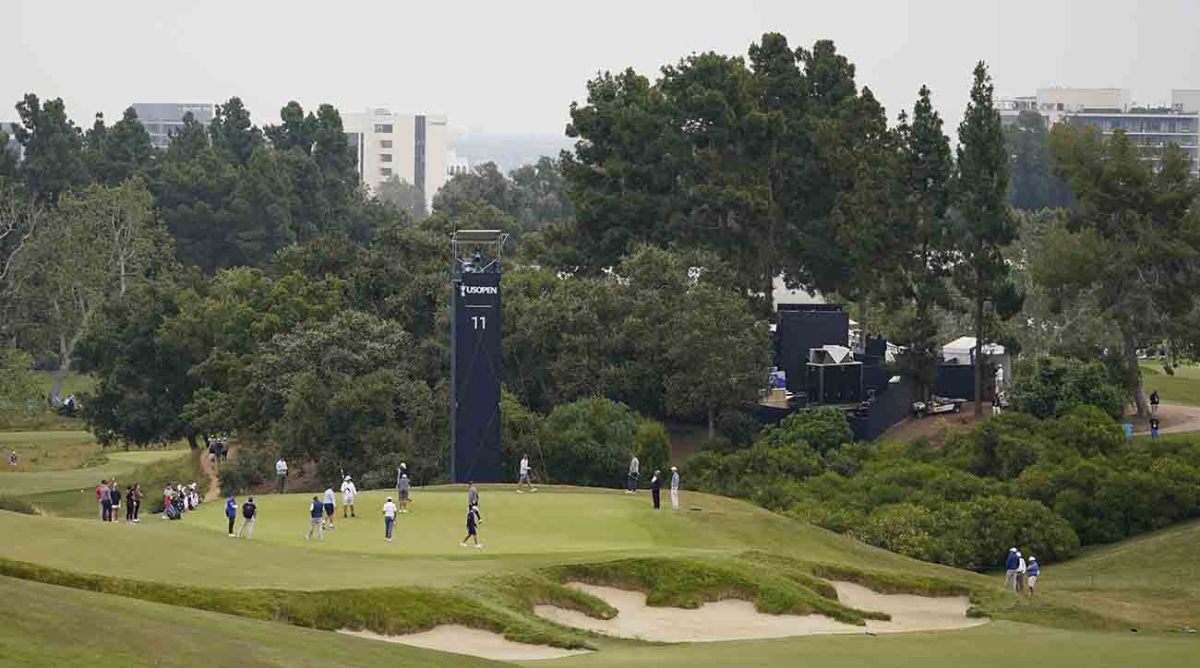Mysterious, Deceptive Los Angeles Country Club Is the Star of This U.S. Open
Lionel Richie, the 73-year-old singer and songwriter who first came to fame in the 1970s as the lead singer of the Commodores, lives in a 17,000-square-foot house that sits on a knoll overlooking the Los Angeles Country Club. Built in 1929 by a scion of the Guggenheim family, some 30 years after the club was established, the Italian Renaissance Revival style-mansion has 28 rooms.
On Wednesday, as I walked the George Thomas-designed LACC North course ahead of the start of the 123rd U.S. Open, I spotted the mansion from the 4th hole, a 228-yard par-3. I kept walking until I found the former Playboy Mansion near the 13th hole, a 500-yard par-4. It’s a long walk through this 7,500-yard layout that has had some doctoring over the years from Gil Hanse and Thomas biographer Geoff Shackelford.
Steep-sided ravines or barrancas bisect the property, providing elegant natural hazards that provide many risk/reward opportunities for players. For example , a barranca comes into play at the drivable par-4 6th hole. “Six is going to be interesting,” Brooks Koepka said. “You could see anything from a 7 to possibly a 2. It'll be a fun hole to just stand on and watch. If I was watching, that's where I'd go stand.”

At majors, it’s typical to have a lot of pre-tournament banter and guessing until play starts, but this is a unique venue. The course has never hosted a U.S. Open and the 2017 Walker Cup was the last tournament held here of any significance. There hasn’t been a U.S. Open in the area since the 1948 championship at Riviera. Many of the players are not sure what to make of it, or the fact there's a U.S. Open in the middle of Los Angeles.
“It’s a very tricky golf course,” says Martin Kaymer, the winner of the 2014 U.S. Open at Pinehurst. “I don’t see 12 or 13 under winning this tournament. It’s difficult to create a lot of good birdie chances because of the length of the holes. I think anybody that’s able to shoot two under each day is going to have a good chance of winning.”
In his Wednesday practice round, Kaymer hit driver off the tee at the 284-yard par-3 7th hole. Still nursing a sore left wrist after surgery in November, Kaymer had 305 yards to the pin. “Some of the players are saying that it’s ridiculous for a par-3 to play that long,” he says. “But for me it’s more mental than anything. I try to see the positives instead of the negatives and accept what the hole gives me.”
The 38-year-old German, who also won the 2010 PGA Championship, hit his tee shot left of the green and got up and down for a par, a score that every player in the field will be happy to have on what promises to be a very difficult hole during the week.
LACC is full of subtle deceptions. “The fairways maybe average (43 yards wide) a little bit wider than they usually are, but when you get fairways that are very firm, any sort of curve you put on the ball makes it play so much smaller,” said Scottie Scheffler.
The greens are bigger on paper but they are small in the spots where pins are located. Thick Kikuyu grass around the greenside bunkers will stop some balls that players are accustomed to seeing going into bunkers, creating what Harris English called some “nasty” shot around the greens.
Here there are a good mix of holes, many of the players say. There are some fun holes like the 15th, which could play 78 yards and the 300-yard par-3 7th. “I think 11 through 18 is probably the toughest stretch on the course,” Scheffler said. Other players trust what they don’t know, secure in the fact that Mother Nature has her own role to play in the outcome.
“I mean, you can do all the prep you want, but it doesn't matter— the wind direction might be different, where you hit your tee ball, pin location,” Koepka said. “There's so much that goes into it. You can do all the research you want, but it won't matter at the end of the day.”
In the U.S. Open, the setup is always a critical part of the drama. This week this golf course with all its quirkiness and natural wonder may shine through in the spotlight, even over these best players in the world. Par, something that this championship has long been measured by, shouldn’t have a place in our thoughts this week. “Par,” said Luke List, sounding like Allen Iverson questioning the importance of practice, “isn’t relevant here.”
Lionel Richie’s house was still on my mind as I walked back toward the clubhouse from the course. I wondered if I would see him or other celebrities on the grounds. Then I realized that I was already witnessing the biggest star of the week: Los Angeles Country Club.
